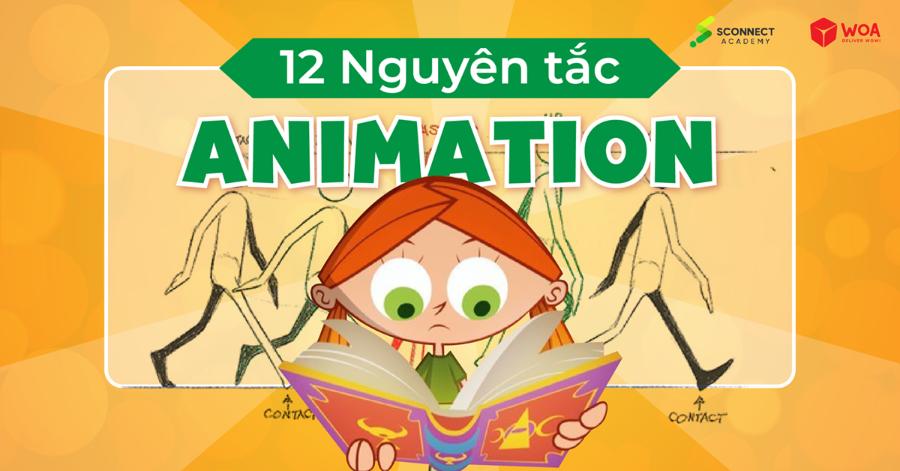Best Selling Products
Mastering Motion: Discovering the Golden Rules of Animation
Nội dung
Master the basic principles of motion in animation to create vivid, smooth and emotional footage.

Animation is not just about creating moving images, but also an art that requires a deep understanding of physical and psychological principles. To create vivid, smooth and emotional animations, mastering the basic principles of motion is extremely important. This article will help you explore the golden principles of animation, helping you improve your skills and create impressive works.
1. Squash and Stretch
Compression and expansion are one of the most basic and important principles of animation, describing the change in shape of an object when subjected to force. This principle helps create a sense of weight, bounce and life for the object.
.jpg)
Detailed explanation :*
When an object collides or moves rapidly, it is compressed in the direction of impact. For example, a ball when it hits the ground will be compressed vertically.
When an object stops or slows down, it stretches in the opposite direction. For example, a bouncing ball stretches vertically.
The degree to which an object is compressed and stretched depends on its stiffness and elasticity. The softer and more elastic an object is, the more it is compressed and stretched.
Application :*
Create a sense of weight: Heavy objects will be less compressed and expanded than light objects.
Bounce: An object with high elasticity will bounce higher and be compressed more.
Create life: Compression and stretching make objects look more alive and natural.
2. Preparation (Anticipation)
Preparation is the act of foreshadowing an upcoming movement. This principle helps the viewer predict the next movement, creating excitement and adding realism to the animation.
Detailed explanation :*
Before performing an action, a person or object often makes a preparatory movement. For example, before jumping, people often bend their knees slightly.
The longer the preparation time, the more powerful the next movement.
Application :*
Creating surprise: Preparatory action can be used to create surprises for the audience.
Increased realism: Prepared movements will look more natural and realistic.
Create focus: Preparatory action helps viewers focus on the upcoming movement.
3. Move along curves (Arcs)
Most movements in nature occur in curves, not straight lines. This principle makes the movements more natural and smooth.
.jpg)
Detailed explanation :*
When an object moves, its trajectory is often a parabola, ellipse, or other complex curve.
Following the principle of curves makes the movement softer and more natural, avoiding stiffness and lack of life.
Application :*
Create natural motion: Curved motion will look more natural and smooth.
Create variety: Curves help to add variety and richness to movement.
Creating emphasis: Curves can be used to create emphasis for movement.
4. Slow In and Slow Out
Movements usually start slowly, speed up in the middle, and slow down at the end. This makes the movement smoother and more natural.
Detailed explanation :*
When an object starts moving, it takes some time to accelerate. Similarly, when it stops, it also takes some time to decelerate.
Applying the principle of slow in and slow out helps the movement become smoother and more natural, avoiding jerkiness and lack of life.
Application :*
Create smooth motion: Slow in and slow out makes the motion smoother and more natural.
Create a sense of weight: Heavy objects will have a longer slow entry and slow exit time than light objects.
Creating emphasis: Speed changes can be used to create emphasis on movement.
5. Follow Through and Overlapping Action
When an object moves, its parts do not move at the same time. This principle makes the motion more complex and realistic.
.jpg)
Detailed explanation :*
Every object has many different parts, and each part will have different inertia and speed of movement.
As an object moves, its parts move in different orders and timings, creating overlapping effects and following action.
Application :*
Create complex movements: Following and overlapping actions make movements more complex and varied.
Increased realism: Motion with following and overlapping actions will look more realistic and natural.
Create life: The overlapping effect makes the object more vivid and flexible.
For example :*
When a person runs, their arms and legs move unevenly.
A person's hair and clothes will also vibrate when walking.
6. Secondary Action
Secondary movements are small, auxiliary movements that complement the main movement. This principle helps make the movement more vivid and detailed.
Detailed explanation :
When an object performs a major motion, it also produces other minor motions, called side effects.
Side effects are often the result of inertia, gravity, or other external factors.
Application :*
Create detailed motion: The secondary effect helps make motion more detailed and rich.
Increased realism: Motion with side effects will look more realistic and natural.
Animate: The secondary reaction makes the object more alive and flexible.
For example :*
When a person walks, their hair and clothes will also vibrate.
When an animal runs, its tail will also wag.
7. Timing and Spacing
Time and distance are two important factors that determine the speed and rhythm of movement.
Detailed explanation :*
Time is the amount of time a motion takes place.
Distance is the distance an object travels in a given period of time.
Adjusting the time and distance makes the motion fast, slow, steady or irregular.
Application :*
Pace: Time and distance determine the speed of the movement.
Rhythm Creation: Variations in timing and spacing create rhythm to movement.
Creating special effects: The combination of time and distance can create special effects for motion.
For example :*
A race car will have a shorter travel time and greater travel distance than a truck.
A walker will have a longer travel time and a shorter travel distance than a runner.
Great! I'm happy to help you write the details of each item in the article about "motion principles in animation". Here is the details of each item, continuing from the previous stop:
8. Exaggeration
Exaggeration is the exaggeration of some features of movement to increase expressiveness and humor. This principle is often used in animation to create comical effects and attract the viewer's attention.
.jpg)
Detailed explanation :
In animation, it is sometimes necessary to exaggerate some aspects of a movement to make it more obvious and impressive.
Exaggeration can be applied to speed, size, shape, expression, and other elements of movement.
However, exaggeration should be used judiciously, avoiding overuse so as not to lose the authenticity of the movement.
Application :
Creating comic effects: Exaggeration is often used to create humorous and comical situations.
Increased expressiveness: Exaggeration helps characters express emotions more strongly and clearly.
Attention grabbing: exaggerated movements tend to attract more attention from viewers.
9. Draw the correct volume (solid drawing)
Drawing the right volume is the creation of images that have three-dimensional space and show the weight of the object. This principle helps objects in animation become more realistic and vivid.
Detailed explanation :
To draw the correct volume, the artist needs to have a solid knowledge of geometry, anatomy and perspective.
Pay attention to proportion, perspective, light and shadow to create images with depth and weight.
Drawing the right amount of volume helps objects in animation interact with each other more logically and naturally.
Application :
Create realistic movement: objects drawn with the right mass will move and interact with the environment more realistically.
Increased liveliness: images with depth and weight will appear more vibrant and engaging.
Improve animation quality: drawing the right volume is an important factor in creating high quality animation.
10. Appeal
Appeal is the creation of characters and scenes that have shapes and expressions that attract viewers. This principle makes animation more interesting and worth watching.
Detailed explanation :
The appeal lies not only in the beautiful appearance, but also in the character's personality, expression and story.
Characters and scenes need to be designed to match the content and style of the animation.
Attraction can be created through many elements, such as shape, color, light, expression, and movement.
Application :
Engaging viewers: attractive characters and scenes will attract viewers' attention more.
Create connection: viewers tend to empathize and connect with more engaging characters.
Increase interactivity: animations with engaging characters and scenes will create a more enjoyable experience for viewers.
11. Conclusion
Mastering the basic principles of motion is the key to creating high-quality animation. By applying these principles flexibly and creatively, you can create unique, impressive and emotional animations.












































